As I’ve discussed recently on this blog, one way of rebuilding and deepening our relationship with the land is through the intentional act of regeneration. This regeneration work, in many cases, starts with the soil. The soil is the web of all life, and without soil, we cannot traditionally grow anything (I say “traditionally” because aquaponics and other systems do have soil-less approaches, but those aren’t really useful to say, converting your front yard into vegetables). Our soils globally are degraded, and most estimates suggest that if things keep going the way they are going, we have only 60 years of topsoil left. Topsoil takes an extremely long time to recover naturally–about 2″ every 1000 years. What is happening in the case of industrial farming, growing of lawns, and so on is that material that should be cycled back into the soil them now ends up blown away, in rivers or in landfills. Ninety percent of our food depends on soil (even animals we eat depend on soil, as they eat grains). Healthy ecosystems cannot thrive without soil. And so, from my perspective, if we want to begin the work of regeneration, we begin that work with soil.

Even if you grow nothing in your soil, sinking carbon and nutrients into the soil is a practice worth engaging in. One soil building technique favored by permaculturists is sheet mulching.
Sheet mulching allows us to recycle otherwise “waste” products (cardboard, newspaper, yard waste, grass clippings, wood chippings from tree work in the neighborhood, etc). It allows us to quickly build soil fertility (speeding up that 1000 year process to maybe 5 or 10 years!). Sheet mulching mimics the natural process of continual layering of organic matter on the top of the soil, and not doing much to disturb the lower soil horizons. And of course, sheet mulching rebuilds our soil, adding vital nutrients and organic matter.
Therefore, sheet mulching has a few benefits over other kinds of garden bed prep:
- It allows you to mimic nature and use a variety of plant matter and other “waste” ingredients
- It allows you to suppress weedy material or grass to have relatively weed-free beds
- It allows you to quickly build soil mass
- It does not disrupt the existing soil web of life, but adds to it
- It allows us to quickly sequester carbon
Fall is the perfect time to begin planning your garden beds for next year and for doing any large-scale lawn conversions–and for those of us in the Northern Hemisphere, fall is just about here. Fall is the best time to work because its much more enjoyable to work in the cool autumn air compared to the hot July air; for existing gardens, this is when things die off; and when the fall leaves drop, a lot of free and available nutrients for gardening activities!
When I was doing my PDC this summer, we visited Ryan Harb’s front-yard garden in Amherst, MA and did a permablitz including a sheet mulch (I will also do a post on Ryan’s front-yard garden sometime this winter after my “harvest” posts are concluded for the year!) I’m going to share his sheet mulching technique, which was a little different from the sheet mulching I used on my Michigan Homestead that I used this in conjunction with other composting techniques. The method I presented on this blog several years ago requires that you have a lot of weed free organic matter (like fall leaves) which may not always be the case.
Ryan’s sheet mulch technique presented in this post is really good when you have weedy/seedy material (like say, from weeds in a garden bed) and you want to use that plant material but not have weed seeds popping up. This technique is also good if you have some woody material, like say some small vines or something. When I began all of my garden beds in my Michigan homestead, I used a very as my primary technique which involved loosening the soil, adding a suppression layer of cardboard, then layering organic matter (mostly weed free) several feet high in the fall and planting in it in the spring.
Materials needed for this technique needed are:
- A huge pile of weedy or non-weedy material (woody material ok), so material you pulled from your existing garden; even things like manures often contain weedy material (I learned this hard way the year after my first sheet mulching); fall leaves (preferably shredded) or other organic matter. You’ll need a good deal of this to build soil.
- Access to a hose/water source
- A lot of cardboard or newspaper or both; enough to cover the pile fully with overlaps.
- Access to finished compost; enough to cover the pile to a depth of 3-4″.
- Some friends to help. Sheet mulching can be a lot of fun with a bunch of people, and not as much fun without them!
Sheet Mulching
There is nothing quite like the thrill of sheet mulching to cover up lawn–it feels very subversive (to the status quo) and empowering (hey, let’s get some veg in here!). So let’s get started!
After a good 2 hour harvesting and weeding session, the PDC group had a large pile of weeds.

And so, to make use of this material, we converted another 4′ x 20′ part of Ryan’s lawn to a productive growing space. We began by laying down the layer of weedy material–the layer was probably about 1.5 feet thick when we started.

After each step you water the pile. The water helps the material break down faster. After reading the Liquid Gold book, I would probably, at this step, also encourage everyone to pee on the pile to add additional nitrogen or add some saved urine for the pile….but we unfortunately skipped that step during the permablitz :). After wetting the pile, we began adding compost. We added 3-4″ of compost the whole way over the pile.


As we added compost, we used the back of the rake to evenly distribute the compost.

After that, we worked to flatten the pile by dancing on it. The dancing is critical–I’m not sure this method will work without dancing at some point. Get in there in your bare feet and go to it!

After this step, we add the cardboard and newspaper. This functions as a weed suppression layer–we need to suppress any weeds that may want to poke up through that rich compost! So while some of us prepped cardboard, others laid it down.


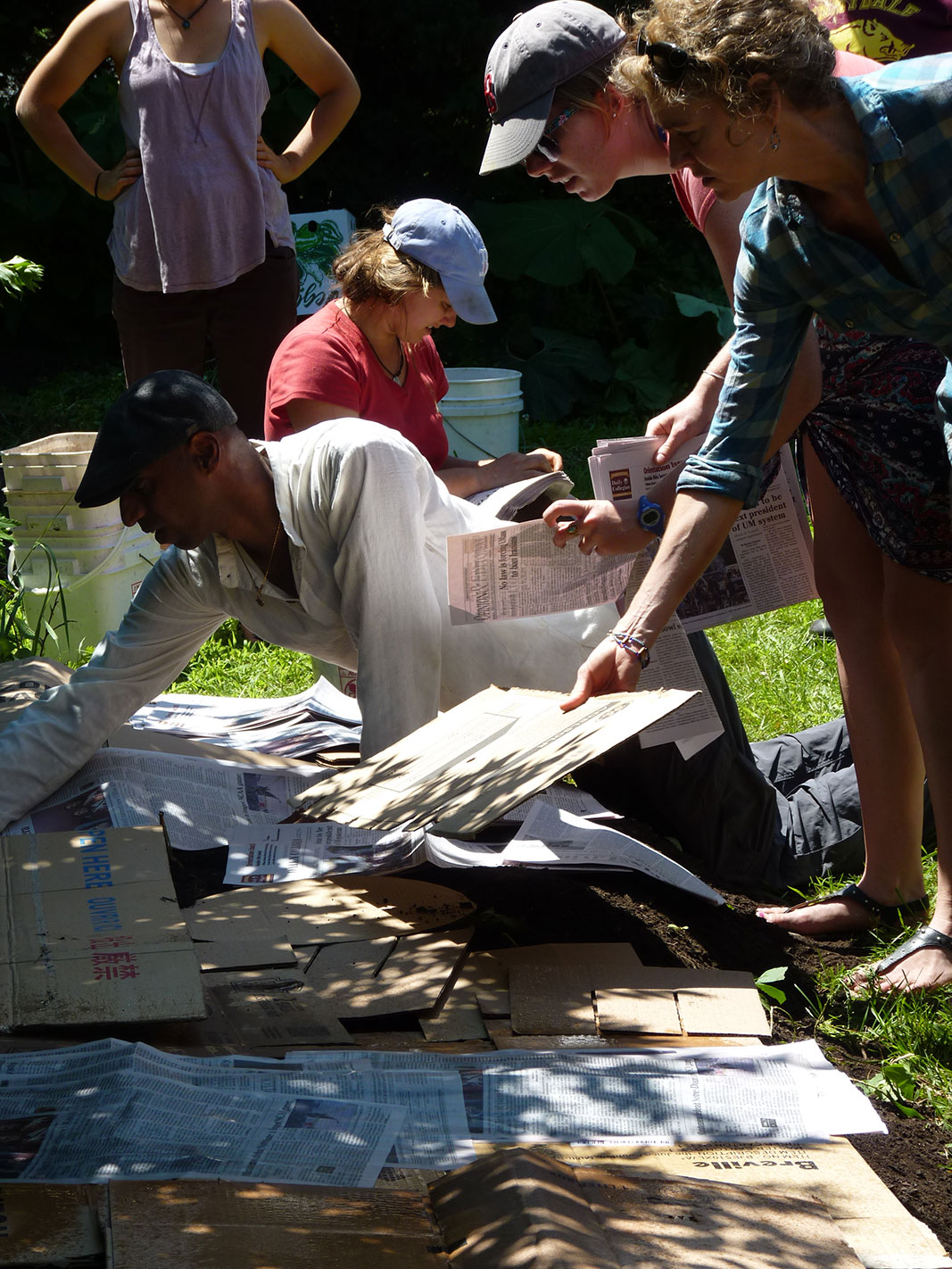
You can get cardboard and newspaper readily–most big stores will have so much cardboard every day that they are generating from materials coming in. Furniture stores or Appliance/TV stores have really large boxes that work well for this. Last week’s newspapers, also, can be readily available. Or if your neighborhood has paper recycling, just go pick boxes up on the curb. Regardless of how you procure your newspaper and cardboard, lay down a good amount. We laid down a full layer of newspaper, paying close attention to the edges.
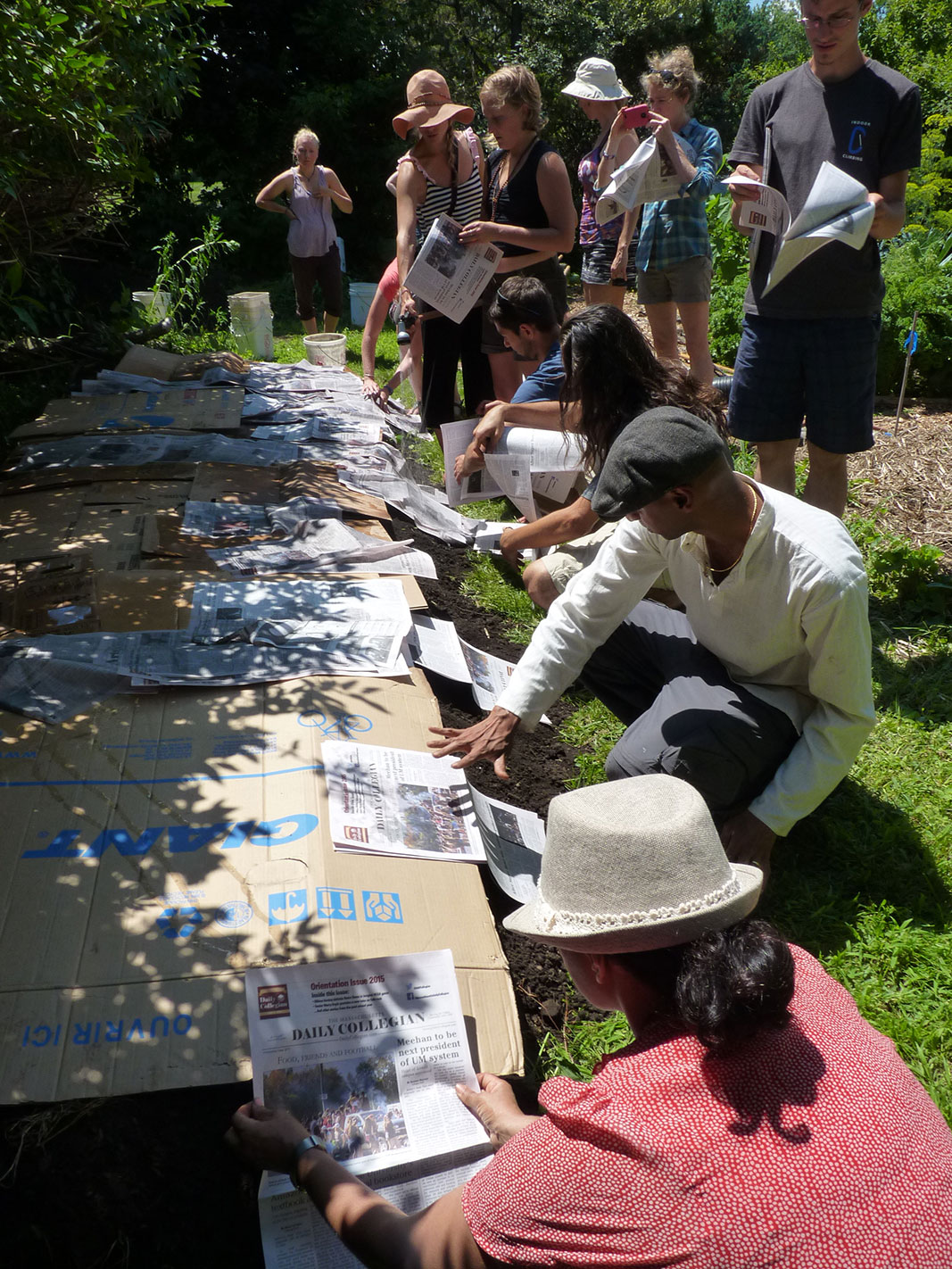
Then we watered the whole pile quite well, again.

The next step is to add the wood chips–this will provide the plants to be planted in this pile next year some mulch, which retains water. Bare soil is not typically found in nature and so we want to mimic nature by using mulching materials. The wood in the chips will eventually break down as well, further adding humus and nutrients to the soil.

Wetting down the pile – we’ve finished!
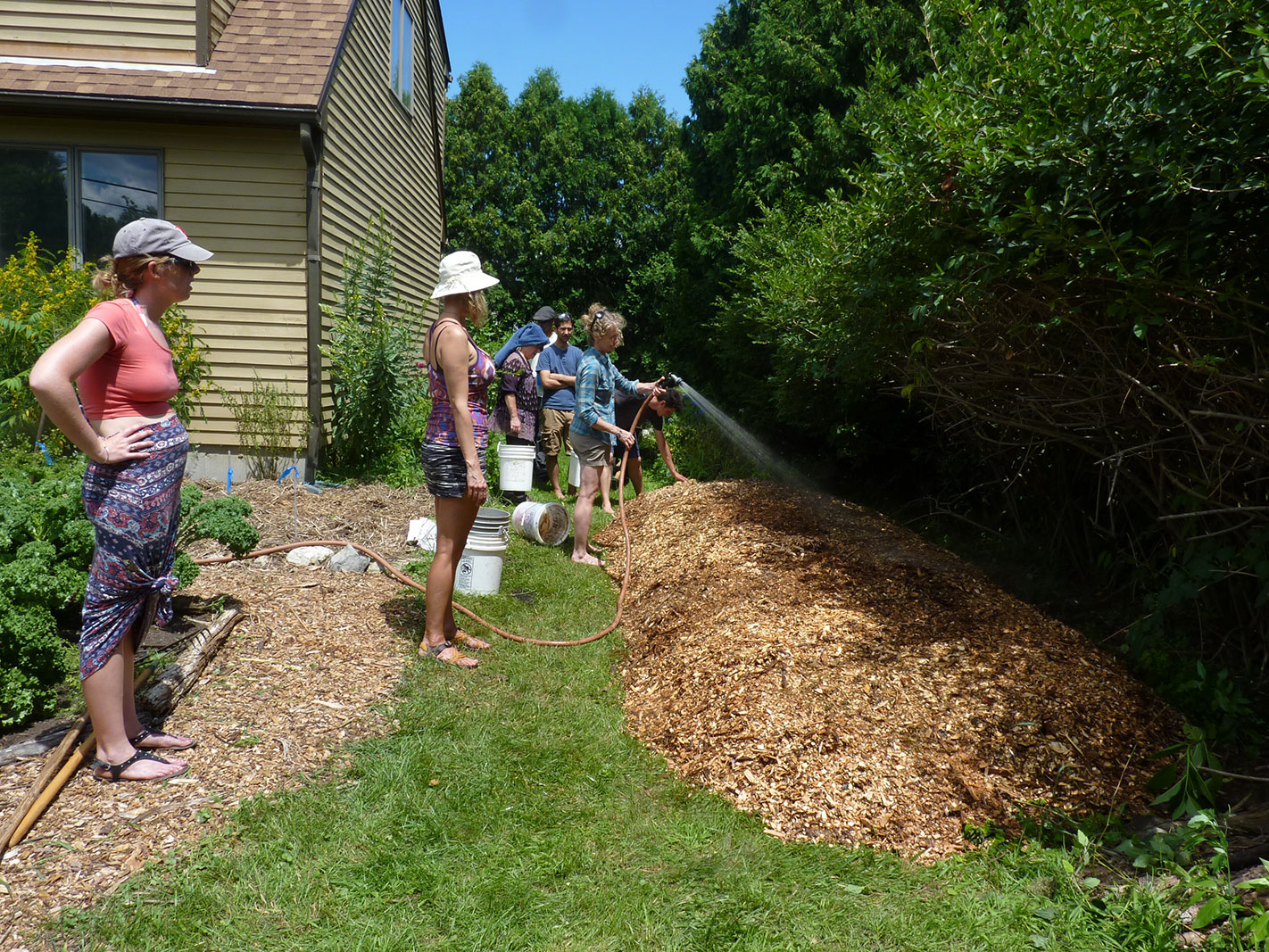
This sheet mulch area won’t be planted in right away–we made this pile in July, and Ryan planned on planting in it in the spring. That’s usually how it works: prepare the piles prior to planting. The reason for this is that the sheet mulch pile can get pretty hot as the green plant material is breaking down and that can be too hot for plant roots to survive. By letting the pile sit, the pile will break down naturally and create an awesome growing medium.
In my own garden at my homestead, in early spring, some of the material from my fresh sheet mulch piles still hadn’t broken down when I went to plant the spring. I added additional compost for around the plant, and the plants did just fine. By the end of that first summer, there was no more cardboard or material–all was beautiful, rich, black soil. Nature does try to slowly reclaim your soil and piles–if you find yourself in a thicket of plants you no longer want, sometimes its easier just sheet mulch over them again. So you sheet mulch, grow a few years, get a bunch of creeping weeds, and then just sheet mulch over it again; this doesn’t harm the soil, and continues to add organic material. Yay for soil regeneration!
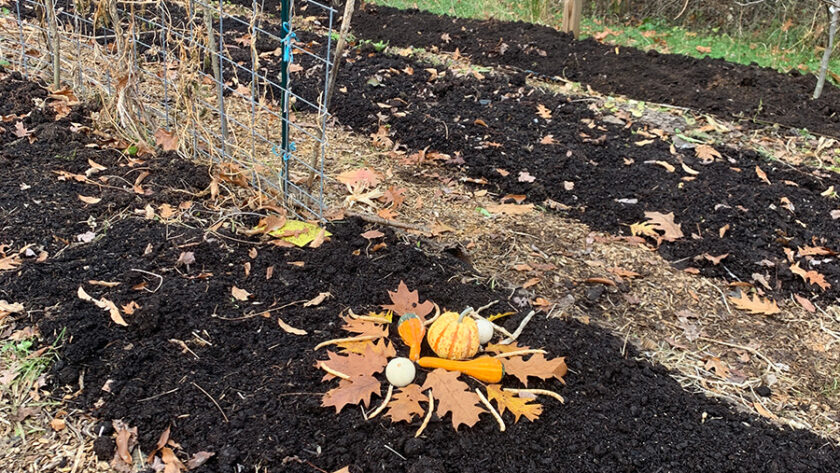


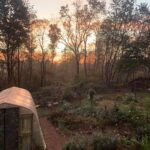
Reblogged this on Laura Bruno's Blog and commented:
This is a different method of sheet mulching than I’ve used before, too. I love the dancing part! I usually lay down the cardboard first and then layer on top of that. This method does the reverse, with apparently good results. Whichever method you use for sheet mulching/lasagna gardening, know that you’re adding the potential for life back into your soil. Most of our front yard and how all of the yard next door has been converted into garden via loads and loads of biomass and cardboard. No one ever complemented this lawn, but people love the garden, not to mention its bounty of flowers and food. The bottom of the post also links to alternative instructions on sheet mulching, so pick a method and enjoy the creative destruction of lawns!
The method you describe is what I used on my homestead as well and what I used for years and years. I like this approach so much because it deals with the weedy material, which I usually composted in a hot pile THEN added to my sheet mulch. This is kind of an all-in-one :).
Yes, I like it, too. I still have some cardboard only areas, so maybe I can put this year’s yard waste under them before I lay them back on the ground.
I ENJOYED READING ABOUT THE WAYS TO ENRICH OUR SOIL. HOWEVER, I WOULD LEAVE OUT THE TOXIC NEWSPAPERS WHICH CONTAIN DIOXIN IN THEIR INKS. DIOXIN IS VERY POISONOUS AND THE EARTH’S SOIL WANTS US HUMANS TO SUPPLY IT WITH … THE PUREST, THE BEST MATERIALS … !
A SERENE WORLD IN BALANCE FOR ALL HUMANS AND NATURE’S CREATIONS,
Countess
Countess, my understanding was that newspapers had soy-based inks. I’d be interested in learning more about dioxin….newspapers are still approved for certified organic farming here in the states. Thank you for the comments!
[…] Read More – https://druidgarden.wordpress.com/2015/09/16/soil-regeneration-lawn-reclamation-creating-a-sheet-mul… […]
[…] to “Make America Great Again”? Start in your own front and backyard by turning lawn to food. (Fall is the perfect time to start a lasagna garden!) Start with your wallet by only purchasing […]
[…] to “Make America Great Again”? Start in your own front and backyard by turning lawn to food. (Fall is the perfect time to start a lasagna garden!) Start with your wallet by only purchasing […]
Thanks for the link!
Thanks for this post! I’ve been making new beds with just cardboard and manure or compost. I’m so happy to be able use use my weeds!
Yeah! No waste is the way to go!
Hi Dana, i am so appreciative of your work, you have given me so much to think about and question. I have sheet mulched by your original method for years with good results but am ready to try a new approach.
I have a question about approaching grass suppression and indeed all weeding from a permissions point of view. I am new to solo druidry and wonder if it is sufficient to consult with the Spirit of Place then explain, thank and bless an area such as this or parts of my garden where I want to remove grass or plants that are overtaking areas. Several times I have thoughtlessly pulled up something then apologised when I realised what I have done. Any advice would be greatfully appreciated.
Sincerely Indigo Hare
Absolutely! I think that permission and gratitude is a critical part of the work. Simply creating time and space for this will be your best bet. For me, this starts with communication and negotiation–I speak to the grass (or poison ivy, or whatever) and we talk about where it will grow and what I would like to grow and we negotiate. I make offerings, I sit with spirit. Sometimes it takes a while. Sometimes a plant wants to be replanted elsewhere or have its seeds scattered. For example, when I was working on my forest hugels, I had two small hawthorns–both of them wanted to be replanted, so I moved them before I started the forest hugels. On the broader land, you can reach an understanding with the land. In our garden areas, we can plant anything we like and if stuff is growing that doesn’t belong there, it is ok to weed. But other parts of the land will remain untouched. Over time, you can come to this kind of agreement and everyone wins :).
Blessings,
Dana